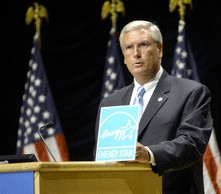Smog Standard Still Hazy
Air Date: Week of March 14, 2008

Ozone pollution is the main source of big-city smog. (Photo: EPA)
The Environmental Protection Agency has set a new standard for the chief component of smog - ozone pollution. But EPA's new standard is under attack from both industry, who wanted no change, and public health advocates who wanted a much stronger rule. Living on Earth's Jeff Young tells us what's behind the decision and what it means for air quality.
Transcript
[THEME]
CURWOOD: From the Jennifer and Ted Stanley Studios in Somerville, Massachusetts, this is Living on Earth. I’m Steve Curwood. For the first time in more than a decade, U.S. environmental officials are strengthening the health standard for ozone – the major ingredient in smog. That means hundreds of communities around the country will have to do more to clean the air of the pollutants that react with sunlight to form toxic, ground-level ozone.
The new standard is only a tiny fraction tighter than the old one. But health experts say even tiny amounts of ozone in the air make a huge difference. Janice Nolen of the American Lung Association says that’s because ozone is so damaging to sensitive tissue in our lungs.
NOLEN: Ozone is like having a sunburn on the lungs – it irritates, it inflames, it aggravates the tissue. And that ends up causing a lot of problems. It can trigger asthma attacks, it can make it – coughing and wheezing. It can send people to the hospital, and now we know that it can actually shorten life.
CURWOOD: Studies link ozone exposure to thousands of hospital visits, missed school and workdays, and premature deaths each year in the U.S. That’s why public health advocates and many government scientists want a much stronger health standard. But industry leaders say the health gains are small compared to the cost of pollution controls they will have to install. Living on Earth’s Jeff Young helps us cut through the haze to get to what’s behind the new ozone standard, and what it means for our air.
YOUNG: It was one of the biggest decisions left for Stephen Johnson in his final year as the Environmental Protection Agency administrator under President Bush. Ozone is the most widespread air pollutant and air quality for millions rests on the limit EPA sets. Johnson says his decision to lower that limit from 80 to 75 parts per billion is historic.
JOHNSON: EPA is meeting the requirement of the Clean Air Act by signing the most stringent standard ever for ozone.

EPA administrator Stephen Johnson says he’d like to change the law so that he could consider the costs of things like the ozone standard. (Photo: EPA)
Dr. Rogene Henderson, a professor at the Lovelace Respiratory Research Institute in New Mexico, leads the EPA’s clean air science advisory committee. That panel of outside experts unanimously recommended a much stronger ozone limit, somewhere between 60 and 70 parts per billion.
HENDERSON: I think he has taken a step in right direction. It’s not as big a step as his advisory committee would have liked. It is discouraging to work very hard and then not have our advice taken.
YOUNG: The EPA analysis says potential health benefits of the limit the panel recommended would be many times greater than the one Johnson chose – more than nine thousand premature deaths could be avoided each year. Henderson says the law requires an adequate margin of safety to protect those most vulnerable to dirty air.
HENDERSON: The main concern, I mean the difference between the level he set and the level we recommended will be that this margin of safety. The sensitive sub-populations such as asthmatics or people with respiratory disease may not be protected at the 75 level.
YOUNG: A separate advisory panel on children’s health reached a similar conclusion, and more than a dozen major public health groups urged Johnson to follow the panel’s advice. But health advocates weren’t the only people weighing in on the ozone decision. Several key lawmakers, including most of the Republicans in the US Senate’s environment committee, told the EPA not to tighten the ozone standard at all. Ohio Republican Senator George Voinovich sent Johnson a letter arguing that the cost to industry would be too great.

Ozone no-no zones. Live in one of these shaded areas? Then you’ve got air quality problems; levels of ozone in these counties exceed the EPA’s new standard. (Photo: EPA)
YOUNG: EPA and White House records show a parade of lobbyists from manufacturers, the oil and refining industries, chemical companies, automakers and even corn growers made the rounds to argue that a tougher standard would be bad for business. It leads some public health advocates to wonder who really had the most influence over Johnson’s decision. Paul Miller is with NESCAUM, a clean air association that represents northeastern states from New Jersey to Maine, areas with major ozone problems.
MILLER: When you look at the available science, you look at what EPA’s own staff recommended. But EPA picked something higher. Then, yes, I’m left scratching my head wondering – what was the basis for that?
YOUNG: Do you think then that Administrator Johnson listened to those industry lobbyists rather than the scientists?
MILLER: I think it’s very possible that someone in the government listened to those arguments, and either Administrator Johnson was in agreement or was told he was in agreement that the standard would not be set within a range that the science called for and outside experts called for.
YOUNG: It is against the law for the EPA to take the cost of compliance into account when setting a health-based standard for ambient air quality. The U.S. Supreme Court settled that issue in a 2001 decision on the Clean Air Act. Johnson insists he followed that law, and based his ozone decision solely on science. However, he also used the announcement of that standard as a chance to propose major changes to the Clean Air Act. One thing he’d like to change is that ban on considering costs in air quality decisions.
JOHNSON: Bottom line: it’s time to modernize the Clean Air Act to improve human health. It should allow decision-makers to consider benefits, costs, risk tradeoffs and feasibility in making decisions about how to clean the air.
YOUNG: On Capitol Hill there was little interest in Johnson’s proposal to dramatically rewrite one the country’s most important environmental laws. There is, however, a lot of interest in a fuller explanation of Johnson’s ozone decision, and why he ignored his science advisors.
That might clear up how the decision was made, but it will likely be a while before the new standard really clears the air. It could take a decade or more to implement new ozone reductions. And even though ozone levels have declined around the country, many major cities still do not comply with the old ozone standard, set more than 10 years ago.
For Living on Earth, I’m Jeff Young in Washington.
Links
For more information from EPA on the ozone decision, click here
Living on Earth wants to hear from you!
Living on Earth
62 Calef Highway, Suite 212
Lee, NH 03861
Telephone: 617-287-4121
E-mail: comments@loe.org
Newsletter [Click here]
Donate to Living on Earth!
Living on Earth is an independent media program and relies entirely on contributions from listeners and institutions supporting public service. Please donate now to preserve an independent environmental voice.
NewsletterLiving on Earth offers a weekly delivery of the show's rundown to your mailbox. Sign up for our newsletter today!
 Sailors For The Sea: Be the change you want to sea.
Sailors For The Sea: Be the change you want to sea.
 The Grantham Foundation for the Protection of the Environment: Committed to protecting and improving the health of the global environment.
The Grantham Foundation for the Protection of the Environment: Committed to protecting and improving the health of the global environment.
 Contribute to Living on Earth and receive, as our gift to you, an archival print of one of Mark Seth Lender's extraordinary wildlife photographs. Follow the link to see Mark's current collection of photographs.
Contribute to Living on Earth and receive, as our gift to you, an archival print of one of Mark Seth Lender's extraordinary wildlife photographs. Follow the link to see Mark's current collection of photographs.
 Buy a signed copy of Mark Seth Lender's book Smeagull the Seagull & support Living on Earth
Buy a signed copy of Mark Seth Lender's book Smeagull the Seagull & support Living on Earth

